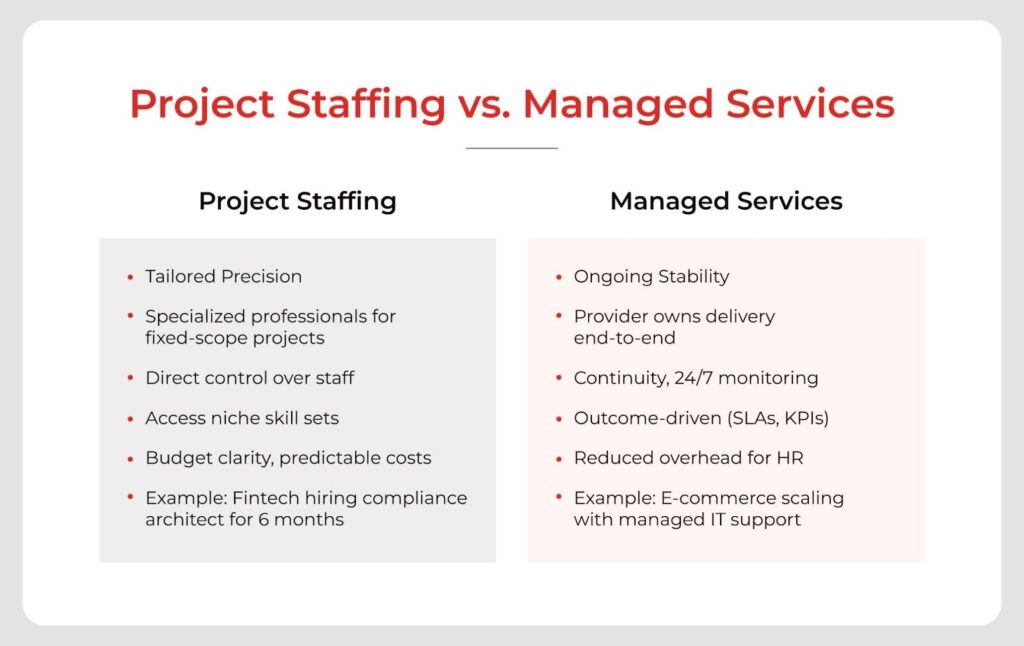Flexibility is a survival strategy in business. Markets move faster than planning cycles, and this is more pronounced in tech hiring. Frameworks evolve every quarter, new compliance demands surface overnight, and product roadmaps get rewritten with every funding round or merger.
For talent leaders, the pressure is relentless: build teams that can pivot quickly without sinking into spiraling costs or rigid contracts.
This is where the choice of staffing model becomes crucial. Among the options, two models dominate boardroom conversations: project staffing and managed services. On paper, both promise agility. Yet when the stakes involve multimillion-dollar product launches, large-scale cloud migrations, or safeguarding enterprise networks, agility comes from having a workforce model that bends without breaking and can expand, contract, or reconfigure at the pace of business.
The real question for leaders is this: when resilience is measured by adaptability, which model actually delivers more flexibility?
Let’s dig deep.
What We Mean by Flexibility in Tech Hiring
Flexibility in this context means:
- Speed of deployment: How quickly can you secure skilled professionals?
- Scalability: Can you scale up during a system rollout and scale down post go-live?
- Specialization: Do you get niche expertise on demand, or a generalist team?
- Risk management: Who shoulders responsibility for delivery and continuity?
Understanding how each model (project staffing solutions vs. managed services) handles these factors is where the real difference emerges.
Project Staffing: Tailored Precision for Defined Needs
Think of project staffing as a precision tool. You bring in specialized professionals for a fixed scope, whether it’s a six-month ERP implementation, a three-month cybersecurity audit, or developing a custom mobile app.
Why Organizations Choose Project Staffing Services
- Direct control: You choose the individuals, align them with your internal teams, and manage them directly.
- Skill depth: You can zero in on niche skill sets. Think a Kubernetes expert for container orchestration or a data scientist with NLP experience.
- Budget clarity: Since project staffing services are tied to defined timelines, costs are predictable.
Think of a fintech startup expanding into digital lending. It may not need a full-time compliance tech architect. But for six months, as they build out regulatory modules, project staffing gives them immediate expertise without long-term overhead.
Managed Services: Ongoing Stability with Shared Ownership
Now imagine managed services as hiring a pit crew, not just a single driver. You outsource a function (say infrastructure monitoring, cloud security, or L1/L2 support) to a provider who owns delivery end-to-end.
Why Organizations Lean on Managed IT Services
- Continuity: Managed service providers ensure 24/7 monitoring, support, and escalation pathways.
- Outcome-driven: The focus shifts from staffing individuals to meeting SLAs and KPIs.
- Reduced overhead: You don’t manage day-to-day tasks; the provider handles recruitment, training, and retention.
For instance, an e-commerce giant scaling during holiday peaks may not want to assemble temporary DevOps staff. With managed IT support services, they secure uptime guarantees, proactive monitoring, and issue resolution without scrambling for ad hoc hires.

Where Project Staffing Outshines Managed Services
There are scenarios where project staffing solutions provide benefits that managed services don’t match up to. These strengths emerge when precision, speed, and cultural fit outweigh the need for ongoing stability.
So when should companies opt for project staffing? Below are some requirements that call for project staffing:
1. Agility in Niche Skill Gaps
When organizations face sudden, specialized needs, project staffing works like a scalpel. It allows you to bring in targeted expertise quickly without carrying unnecessary overhead. Instead of waiting for a managed services provider to shuffle resources, you can handpick the exact professional you need.
Example: A healthcare tech company building a machine learning model for diagnostic imaging may need a data scientist with niche experience in medical datasets. With project staffing, you can hire that expertise for a three-month sprint, ensuring progress without the drag of long-term contracts.
2. Cultural Alignment
Unlike managed services, where delivery teams often operate at arm’s length, project staffing embeds talent within your own environment. These professionals adopt your workflows, tools, and communication rhythms. That cultural alignment reduces friction and accelerates collaboration, particularly when in-house teams are heavily involved in delivery.
Think of it this way: If you’re building a product that requires daily stand-ups, shared code repositories, and rapid iteration, having staffed professionals sitting alongside your core team creates a rhythm managed services rarely replicate.
3. Short-Term Innovation
For initiatives where speed and experimentation matter more than stability, project staffing services give you breathing room. They allow you to test new technologies, run pilot programs, or execute proof-of-concepts (PoCs) without committing to a long-term service contract.
Example: A retail firm exploring generative AI chatbots may not know if the initiative will scale beyond a pilot. Project staffing lets them test, learn, and pivot without locking into an inflexible managed IT services arrangement.
Where Managed Services Take the Lead
There are equally strong cases where managed services outpace project staffing. These advantages become clear when continuity, accountability, and global reach are more important than niche agility.
1. Long-Term Consistency
For functions like IT managed services, infrastructure support, or cybersecurity monitoring that demand uninterrupted delivery, continuity matters more than short-term flexibility. Managed services ensure a steady flow of expertise, processes, and tools without the disruption of constant onboarding and offboarding.
Example: A financial institution running mission-critical payment gateways cannot risk downtime. With managed services, they secure 24/7 monitoring and guaranteed SLAs, ensuring that systems stay resilient even during spikes in demand.
2. Shared Accountability
With project staffing, responsibility for output largely sits with the organization. With managed services, accountability shifts. The provider takes ownership of delivery risk, service quality, and compliance. This frees internal leaders to focus on strategy rather than firefighting operational issues.
Think of it as insurance: You’re not just paying for people, you’re paying for outcomes like uptime, response times, data integrity. That assurance is often worth more than the individual skills themselves.
3. Scalability at Scale
When growth isn’t about a few specialists but entire teams across geographies, managed IT support services deliver scale without straining your HR function. Providers can extend coverage across time zones, languages, and regulatory environments, enabling seamless global operations.
Example: A SaaS company expanding from North America to Europe and Asia doesn’t want to rebuild IT support from scratch in each region. A managed services provider can instantly extend 24/7 coverage, aligning with local compliance while maintaining centralized visibility.
The Nuanced Middle Ground
In practice, many tech enterprises adopt a hybrid model. They use project staffing services for bursts of innovation (say, migrating to a new ERP) while relying on managed services for steady-state operations (maintaining the ERP once it’s live).
This mix allows:
- Short-term agility.
- Long-term predictability.
- Balanced cost structures.
It’s less about choosing one over the other and more about sequencing both intelligently.
Making the Choice: What Leaders Should Ask?
Before deciding, HR and TA leaders should ask:
- Is the need temporary or ongoing?
- Do we want direct control over staff or accountability from a provider?
- What’s the risk if continuity fails?
- Is innovation speed or operational stability the bigger priority right now?
These questions reframe the decision from a binary “either/or” to a strategic “when and where.”
To Conclude: Flexibility Is Contextual, Not Absolute
Neither project staffing nor managed services is inherently “more flexible.” Flexibility depends on context: the project, the timeline, the risks, and the growth trajectory of your business.
For organizations in fast-moving sectors like fintech, healthtech, or AI, project staffing solutions often provide sharper adaptability in moments of change. For enterprises running global operations or handling sensitive workloads, managed IT services anchor stability while absorbing delivery risk.
What truly separates resilient businesses is not the model they pick but their ability to fluidly switch between models as circumstances demand.
Forward-looking talent leaders are already building ecosystems where project staffing services fuel bursts of innovation, while managed IT support services maintain an operational backbone. That interplay is what defines real flexibility in tech hiring.
Ready to unlock true workforce flexibility?
At SPECTRAFORCE, we design workforce solutions tailored to your business goals. Whether you need project staffing services for innovation bursts or managed IT support services for ongoing stability, we help you build a talent ecosystem that scales, adapts, and delivers.
Connect with SPECTRAFORCE today to explore how our expertise can give your tech hiring strategy the agility it needs.
FAQs
Project Staffing provides flexibility in tech hiring by letting teams handpick experts, scale up or down quickly, and embed talent into in-house workflows without long, rigid commitments. For short bursts like PoCs, migrations, or compliance builds project staffing solutions reduce time-to-skill and preserve direct control over deliverables, team rhythm, and budget clarity.
Managed Services are more effective than Project Staffing when continuity, accountability, and 24/7 coverage matter more than niche speed. Think managed IT support services for infrastructure, security operations, or global service desks. Managed services shift risk to the provider, enforce SLAs, and standardize operations at scale, making them ideal for ongoing stability rather than episodic tech hiring.
Typically, project staffing offers more control because hiring tech talent directly into the team keeps timelines, tooling, and sequencing in the organization’s hands. By contrast, managed services centralize control with the provider, trading hands-on oversight for outcome guarantees and operational lift.
Leaders can choose between project staffing and managed services by mapping need (temporary vs ongoing), risk tolerance (retain vs transfer), control preferences (in-house cadence vs provider-led), and scale (targeted roles vs always-on coverage). A pragmatic path is hybrid: use project staffing services for innovation spikes and IT managed services for steady-state functions, sequencing both to match product cycles and budget discipline.



